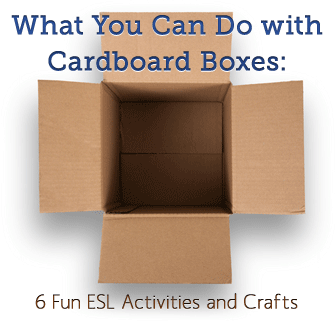What You Can Do with a Paper Bag: 9 Splendid ESL Activities


Were we even remotely interested in the new refrigerator or TV set? Not really! We wanted to play with the box! There are great ways to use cardboard boxes in the ESL classroom and here are just a few to get you started:
Fairy tales are all the rage right now, with girls and boys, and you can have fun with fairy tales in your ESL class. But first, why not make this easy cardboard box castle with your class? Watch the video, follow the simple step-by-step instructions and help your students decorate your castle. With the help of some small dolls or action figures, act out scenes from a fairy tale you’ve read for role plays with a twist!
Dioramas are perfect for capturing a scene from a story – and cardboard boxes are the ideal material for your class diorama. Simply cut out a rectangle from one of the sides of the box, like a window. Then have your class assist you in recreating a scene from a story or book you’ve read. They can use a variety of materials, from modeling clay to cardboard cutouts. Dioramas are also great for re-creating typical animal habitats, like rainforest or jungle, or even a room in a house. Divide your students into groups and assign each room in the house for them to re-create in their own diorama. And don’t forget holiday dioramas: from the first Thanksgiving to a spooky graveyard filled with monsters for Halloween, the possibilities are endless!
Want to practice asking for and giving directions? How about using a miniature town instead of an old, boring, flat map? Use small cardboard boxes of different sizes, like small cereal or cookie boxes. Have your students create a building out of each: movie theater, bank, school, etc…all of the essential places in a town. Next, you’ll need a large piece of cardboard to build your town. Arrange and glue all of the buildings to form streets your students will travel around. Your class can make the town as detailed as they want by adding fire hydrants, stops signs, and bus stops! Use toy cars to drive around and ask for directions.
It is essential to help your students acquire more vocabulary, but why not capitalize on their innate curiosity? How many times has a student asked you about the meaning of a word? Countless times, most likely. What if you had a card for every vocabulary-related question a student asked? Set up a Vocabulary Box in a corner of the room! It can have a slit on the front or the top, like a ballot box. Wrap it up in pretty paper and leave the slit as the only opening. Each time a student asks about a word he or she does not understand, go through the following steps:
Surely you’ll have your class practice plenty of letter writing, but it’s so much more fun to have a mailbox to put their letters into! Have each of your students write a letter to a classmate, put it in an envelope and address it. Students put their letter into the mailbox. Then you can be the postman/woman and deliver them or have another student act as postman/woman. You can also use the mailbox for homework assignments or special occasions such as Valentine’s Day or Christmas, where students will get the chance to write to Santa. Watch this tutorial to make your mailbox and decorate it with your class!
What would a robot family talk about at the dinner table? “Pass the nuts and bolts, please”, one of them could say. For a fun family role play activity, first have your students create a robot head out of a cardboard box for each of the family members. When they’re all done, students take turns acting out different role plays, but as robots! In the shopping role play, what would the momma-bot buy at the store? What about household chores? You can have any role play you like, but the robots will certainly make them more interesting!
Why not capitalize on our innate fascination with boxes and the opportunities they hold?
And for more articles in our “What You Can Do with…” series go to our ESL Essentials section. There you’ll find these and more!